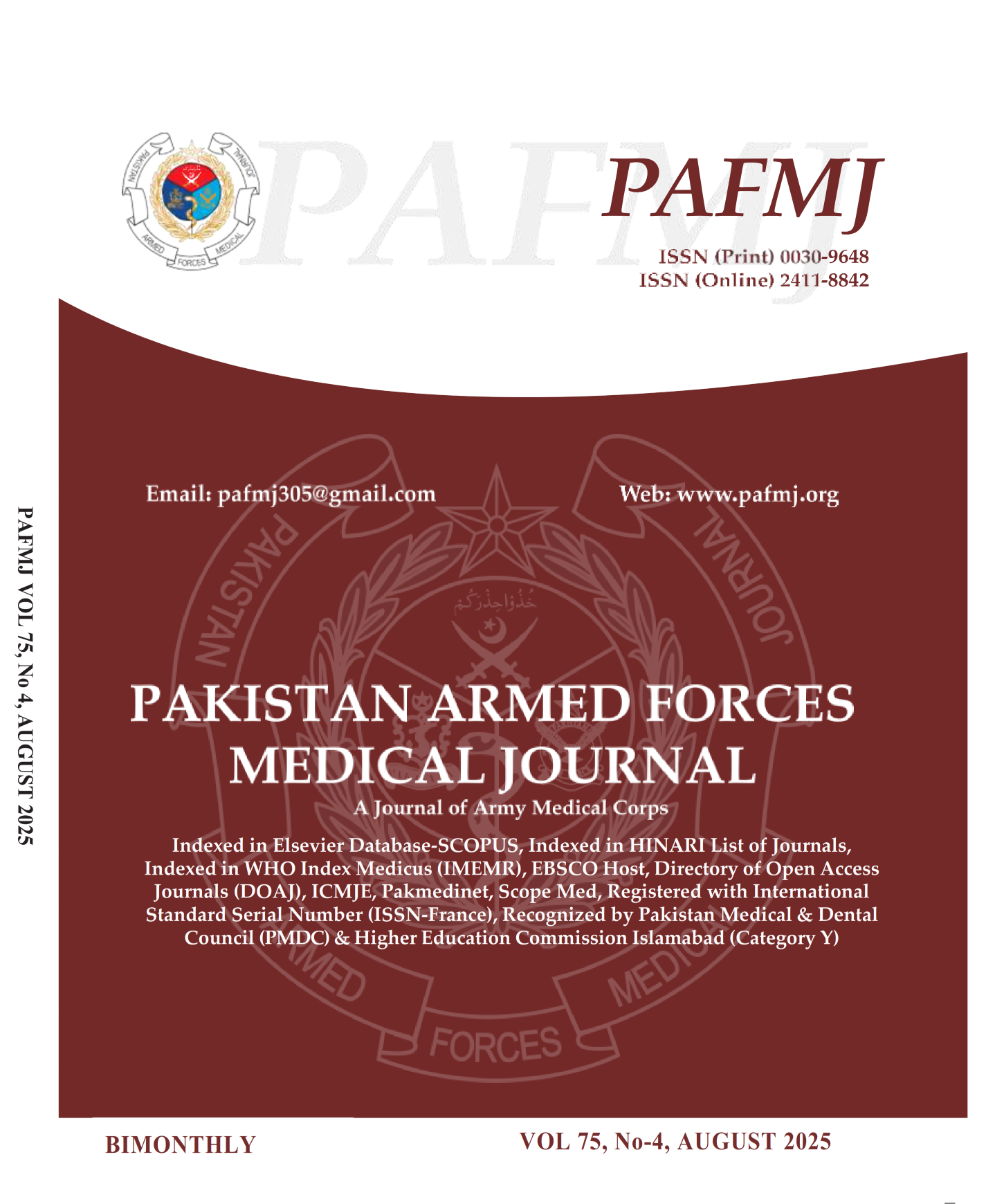A Split-Face Comparative Study of ACNE Scar Treatment Using Microneedle Radiofrequency Plus Fractional Carbon Dioxide (Co2) Versus Microneedle Without Radiofrequency Plus Carbon Dioxide (Co2)
DOI:
https://doi.org/10.51253/pafmj.v75i4.8159Keywords:
Acne scars, Microneedling, Radiofrequency.Abstract
Objective: To compare microneedle radiofrequency plus fraction CO2 application on one side versus microneedle without radiofrequency plus CO2 application on the other side of the face in the treatment of acne scars.
Study Design: Quasi-experimental study.
Place and Duration of Study: Dermatology Department, Ghurki Trust Teaching Hospital, Lahore, Pakistan, from Apr 2021 to Jan 2022.
Methodology: A total of 78 patients of both genders between the ages of 15 to 45 years having acne scars with Grades 2–4 were included. Patients with history of previous acne treatments, pregnancy, and ischemic heart disease were excluded. It was a split-face study in which 78 patients underwent acne scar treatment with microneedle radiofrequency plus fraction CO2 on left side of face and microneedle without radiofrequency plus CO2 application on the right side of face. All patients were followed 2 months after the completion of treatment.
Results: The mean age of patients was 25.95±6.61 years. There were 52 females (66.7%) and 26 male patients (33.3%). The mean Goodman and Baron Scar score at the start of treatment and at 2 months follow up reduced from 31.64±4.13 to 8.73 ± 3.07 on left side of face while it decreased from 30.49±4.08 to 10.96±3.08 on right side of face, the difference between the groups was statistically significant (p<0.001).
Conclusion: Microneedle radiofrequency plus fraction CO2 application is better than microneedle without radiofrequency plus CO2 application in the treatment of acne scars.
Downloads
References
1. Babar O, Mobeen A. Prevalence and psychological impact of acne vulgaris in female undergraduate medical students of Rawalpindi and Islamabad, Pakistan. Cureus 2019; 11(9): e5722.
https://doi.org/10.7759/cureus.5722
2. Abdel Hay R, Shalaby K, Zaher H, Hafez V, Chi CC, Dimitri S, et al. Interventions for acne scars. Cochrane Database Syst Rev. 2016; 4(4): CD011946.
https://doi.org/10.1002/14651858.cd011946.pub2
3. Kravvas G, Al-Niaimi F. A systematic review of treatments for acne scarring. Part 2: energy-based techniques. Scars Burn Heal 2018; 4: 2059513118793420.
https://doi.org/10.1177/2059513118793420
4. Ali G, Mehtab K, Sheikh ZA, Ali HG, Abdel Kader S, Mansoor H, et al. Beliefs and perceptions of acne among a sample of students from Sindh Medical College, Karachi. J Pak Med Assoc 2010; 60(1): 51-54.
5. Pooja T, Gopal KVT, Rao TN, Devi BG, Kumar SA. A randomized study to evaluate the efficacy fractional CO2 laser, microneedling and platelet rich plasma in post-acne scarring. Indian Dermatol Online J 2020; 11(3): 349-354.
https://doi.org/10.4103/idoj.idoj_370_19
6. Tan J, Kang S, Leyden J. Prevalence and risk factors of acne scarring among patients consulting dermatologists in the USA. J Drugs Dermatol 2017; 16(2): 97-102.
7. Arsiwala NZ, Inamadar AC, Adya KA. A comparative study to assess the efficacy of fractional carbon dioxide laser and combination of fractional carbon dioxide laser with topical autologous platelet-rich plasma in post-acne atrophic scars. J Cutan Aesthet Surg 2020; 13(1): 11-17.
https://doi.org/10.4103/jcas.jcas_142_19
8. Pall A, Pall S. An Innovative approach of treating acne scars using bipolar rotational stamping and monopolar criss-cross technique with insulated microneedling radiofrequency in Asians. J Cutan Aesthet Surg 2021; 14(2): 191-202.
https://doi.org/10.4103/jcas.jcas_89_19
9. Boen M, Jacob C. A review and update of treatment options using the acne scar classification system. Dermatol Surg 2019; 45(3): 411-422. https://doi.org/10.1097/dss.0000000000001765
10. Taub AF. The treatment of acne scars, a 30-year journey. Am J Clin Dermatol 2019; 20(5): 683-690.
https://doi.org/10.1007/s40257-019-00451-9
11. Ochi H, Tan L, Tan WP, Goh CL. Treatment of facial acne scarring with fractional carbon dioxide laser in Asians, a retrospective analysis of efficacy and complications. Dermatol Surg 2017; 43(9): 1137-1143.
https://doi.org/10.1097/dss.0000000000001219
12. Rajput CD, Gore SB, Ansari MK, Shah SM. A prospective, nonrandomized, open-label study, comparing the efficacy, safety, and tolerability of fractional CO2 laser versus fractional microneedling radio frequency in acne scars. J Cutan Aesthet Surg 2021; 14(2): 177-183.
https://doi.org/10.4103/jcas.jcas_65_19
13. Faghihi G, Poostiyan N, Asilian A, Abtahi-Naeini B, Shahbazi M, Iraji F, et al. Efficacy of fractionated microneedle radiofrequency with and without adding subcision for the treatment of atrophic facial acne scars: A randomized split-face clinical study. J Cosmet Dermatol 2017; 16(2): 223-229.
https://doi.org/10.1111/jocd.12346
14. Goodman GJ, Baron JA. Postacne scarring--a quantitative global scarring grading system. J Cosmet Dermatol 2006; 5(1): 48-52.
https://doi.org/10.1111/j.1473-2165.2006.00222.x
15. Kaçar N, Dursun R, Akbay M, Gökşin Ş. The early and late efficacy of single-pass fractional carbondioxide laser, fractional radiofrequency, and their combination in acne scars: A prospective, split-face, single-blinded, controlled clinical study. Dermatol Ther 2020; 33(6): e14444.
http://dx.doi.org/10.1111/dth.14444
16. Nandini AS, Sankey SM, Sowmya CS, Sharath Kumar BC. Split-face comparative study of efficacy of platelet-rich plasma combined with microneedling versus microneedling alone in treatment of post-acne scars. J Cutan Aesthet Surg 2021; 14(1): 26-31. https://doi.org/10.4103/jcas.jcas_160_18
17. Tatlıparmak A, Aksoy B, Shishehgarkhaneh LR, Gökdemir G, Koç E. Use of combined fractional carbon dioxide laser and fractional microneedle radiofrequency for the treatment of acne scars: A retrospective analysis of 1-month treatment outcome on scar severity and patient satisfaction. J Cosmet Dermatol 2020; 19(1): 115-121. https://doi.org/10.1111/jocd.13004
18. Reddy KY, Swaroop R, Mallaya RR, Ghosh A, Krishn ZS, A comparative study of efficacy of fractional carbondioxide laser and microneedling fractonal radiofrequency in the treatment of acne scars. IP Indian J Clin Exp Dermatol 2021; 7(1): 47-53. https://doi.org/10.18231/j.ijced.2021.009
19. Juhasz MLW, Cohen JL. Microneedling for the treatment of scars: an update for clinicians. Clin Cosmet Investig Dermatol 2020; 13: 997-1003. https://doi.org/10.2147/ccid.s267192
Downloads
Published
Issue
Section
License
Copyright (c) 2025 Beenish Jabeen Bajwa, Sumera Hanif, Haroon Nabi, Talat Akbar, Saman Iqbal Goraya, Tassmia Cheema

This work is licensed under a Creative Commons Attribution-NonCommercial 4.0 International License.















